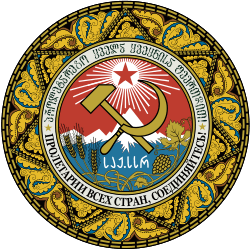Red star

A red star, five-pointed and filled (★), is an important symbol often associated with communist ideology, particularly in combination with hammer and sickle. It has been widely used in flags, state emblems, monuments, ornaments, and logos.
Symbol of communism
The five-pointed red star has often served since about 1917 as a symbol of communism. One interpretation sees the five points as representing the five fingers of the worker's hand, as well as the five continents. A lesser-known suggestion is that the five points on the star were intended to represent the five social groups that would lead Russia to communism: the youth, the military, the industrial labourers, the agricultural workers or peasantry and the intelligentsia.
A red star became one of the emblems, symbols and signals representing the Soviet Union under the rule of the Communist Party, along with, for example, the hammer and sickle. In Soviet heraldry, the red star symbolized the Red Army and the military service, as opposed to the hammer and sickle, which symbolized peaceful labour.
Different countries across Europe treat the symbol very differently: some have passed laws banning it by claiming that it represents "a totalitarian ideology", but other countries hold a very positive view of it as a symbol of antifascism and resistance against Nazi occupation.
 Red star, Red Army 1918
Red star, Red Army 1918 Red Cavalry poster with budenovka, 1920
Red Cavalry poster with budenovka, 1920.svg.png) Coat of arms of the Latvian Socialist Soviet Republic (1919–1920)
Coat of arms of the Latvian Socialist Soviet Republic (1919–1920)
History
The star's origins as a symbol of a mass political movement date to the times of the Russian Civil War of 1917-1922 and the end of the First World War in 1918, but the precise first use remains unknown. It is most often thought that Russian troops fleeing from the Austrian and German fronts found themselves in Moscow in 1917 and mixed with the local Moscow garrison. To distinguish the Moscow troops from the influx of retreating front-liners, officers gave out tin stars to the Moscow garrison soldiers to wear on their hats. When those troops joined the Red Army and the Bolsheviks they painted their tin stars red, the color of socialism, thus creating the original red star.[1]
Another claimed origin for the red star relates to an alleged encounter between Leon Trotsky and Nikolai Krylenko. Krylenko, an Esperantist, wore a green-star lapel badge; Trotsky enquired as to its meaning and received an explanation that each arm of the star represented one of the five traditional continents. On hearing that, Trotsky specified that soldiers of the Red Army should wear a similar, red, star.[2] In a speech given by Trotsky in 1923, he mentions the red star:
For the seventh time since the overthrow of Tsardom, for the sixth time under the sickle and hammer of the Soviets and the Red star of battle[3]
And the badge was used in the Red Army during the Civil War:
Immediately after the October revolution [1917] all ranks of the 3rd Petrograd regiment wore their old uniforms but with shoulder-board removed and with Tsarist cap insignia replaced by the red star[4]

Shortly before the founding of the Soviet Union, in mid-March 1916 the U.S. Army Signal Corps' aviation section used the red star[5] for the national insignia for U.S. aircraft during the Pancho Villa Expedition on the aircraft of the Signal Corps' 1st Aero Squadron to apprehend the Mexican revolutionary, as just one instance of a series of interesting "crossovers" of American and Russian/Soviet military aircraft markings, during the 20th century's first three decades.
Joseph Stalin is also known for wearing a pendant resembling the red star, as he did at the Teheran Conference in 1943.
It has also been suggested that the use of the red star might be related to the popular novel called Red Star from 1908 by Alexander Bogdanov.[6]
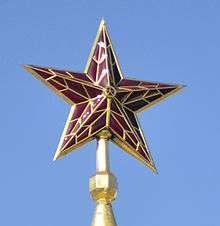 Kremlin Star, Moscow, (1937)
Kremlin Star, Moscow, (1937)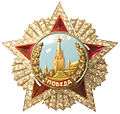 Soviet Order of Victory, (1945), USSR
Soviet Order of Victory, (1945), USSR Plate by Adamovich, (1921), USSR
Plate by Adamovich, (1921), USSR
Wider use
Following its adoption as an emblem of the Soviet Union, the red star became a symbol for communism in a larger sense. The symbol became one of the most prominent of the Soviet Union, adorning all official buildings, awards and insignia. Sometimes the hammer and sickle appeared depicted inside or below the star. In 1930 the Soviet Union established the Order of the Red Star and awarded its insignia to Red Army and Soviet Navy personnel for "exceptional service in the cause of the defense of the Soviet Union in both war and peace".
Several Communist states subsequently adopted the red star symbol, often placing it on their respective flags and coats of arms - for example on the flag of the Socialist Federal Republic of Yugoslavia. Separatist and socialist movements also sometimes adopted the red star, as on the Estelada flag in the Catalan countries.
In former Yugoslavia the red star was not only considered a communist symbol, as were the hammer and sickle; but also as a symbol of resistance against fascist and Nazi occupation and associated ethnic policies. Tito's partisans, often including people with different political views, or even with a religious background, wore the red star as an identification symbol. As the use of the red star spread to communism in East Asia, it was adapted: while some states kept the star as it was, some used a yellow star, particularly on a red field, with the same symbolism. The Far Eastern Republic of 1920 to 1922 used a yellow star on its military uniforms, and the flag of the People's Republic of China has five yellow stars on a red field. The flag of Vietnam also has a yellow star on a red field. In Brazil, however, the red star remained as it was.
 Laureate Plate of Madrid award of the Spanish Republic (1937-1939)
Laureate Plate of Madrid award of the Spanish Republic (1937-1939)
 Coat of arms of the Federal State of Croatia (1943–1947)
Coat of arms of the Federal State of Croatia (1943–1947) Coat of arms of Transnistria (1991)
Coat of arms of Transnistria (1991)
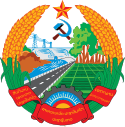 Emblem of Laos (1975-1991)
Emblem of Laos (1975-1991) Emblem of the People's Republic of Mongolia (1960-1992)
Emblem of the People's Republic of Mongolia (1960-1992) Coat of arms of the People's Republic of Benin (1975–1990)
Coat of arms of the People's Republic of Benin (1975–1990) Coat of arms of Burkina Faso 1984-1997
Coat of arms of Burkina Faso 1984-1997
.svg.png)
.svg.png) The Coat of arms of communist Czechoslovakia (1961-1989)
The Coat of arms of communist Czechoslovakia (1961-1989)
The Soviet and Russian Federation military newspaper is called the Red Star (Russian: Krasnaya Zvezda).[7] Several sporting clubs from countries ruled by Communist Parties used the red star as a symbol and named themselves after it, such as the 1991 European and World champions the Yugoslav club Red Star Belgrade (Serbian: Crvena zvezda/Црвена звезда), the East German Roter Stern Leipzig, the Angolan Estrela Vermelha do Huambo, the Estrela Vermelha from Beira, Mozambique or the Czechoslovak Rudá Hvězda Brno. Some sports teams from non-communist countries used it, such as French Red Star from Paris, Swiss club FC Red Star Zürich, English Seaham Red Star F.C., and even an American women's soccer club (Chicago Red Stars -- though in that case the star is based on the flag of Chicago and not the communist logo).
 Civil ensign of the Socialist Federal Republic of Yugoslavia
Civil ensign of the Socialist Federal Republic of Yugoslavia Flag of the Italian Partisan 63rd Brigade
Flag of the Italian Partisan 63rd Brigade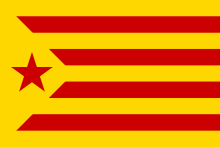 Catalan red estelada
Catalan red estelada Galician estreleira
Galician estreleira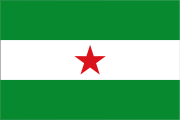 Andalusian Arbonaida
Andalusian Arbonaida
The Brazilian leftist Worker's Party uses a red star as its symbol with the party acronym (Portuguese: Partido dos Trabalhadores - PT) inside. Hugo Chávez and his supporters in Venezuela have used the red star in numerous symbols and logos, and have proposed including it in the logo of the United Socialist Party of Venezuela (PSUV). It was also used throughout 2007 as a symbol of the "5 Engines of the Bolivarian Socialist Revolution". It is also used by the militant South African shack-dweller's movement Abahlali baseMjondolo.
The Red Army Faction, a West German militant group, used a red star paired with a Heckler & Koch MP5 in their highly recognizable insignia.
The red star was included in the flag of the Chiapas armed revolutionary group Ejército Zapatista de Liberación Nacional (EZLN) or Zapatista Army of National Liberation upon their formation in 1994. The same flag, a black flag with a red star, was used by US rock band Rage Against the Machine – who were vocal supporters of the EZLN and other left causes – so much so that the symbol came to be associated with the band, separate from the EZLN.
North Korea's Red Star operating system takes its name from the communist red star.
 Soviet Military Air Force (1943-1991), Russian Military Air Force (1992-2010) and Belarusian Military Air Force and Air Defence Forces roundel
Soviet Military Air Force (1943-1991), Russian Military Air Force (1992-2010) and Belarusian Military Air Force and Air Defence Forces roundel Symbol of the Ministry of Defense of the Republic of Belarus
Symbol of the Ministry of Defense of the Republic of Belarus Russian Military Air Force roundel
Russian Military Air Force roundel Emblem of the People's Liberation Army
Emblem of the People's Liberation Army The coat of arms of the Armed Forces of the Republic of Kazakhstan
The coat of arms of the Armed Forces of the Republic of Kazakhstan Symbol of the Brazilian Worker's Party
Symbol of the Brazilian Worker's Party Insignia of the Red Army Faction
Insignia of the Red Army Faction
By March 2010, the Russian government readopted the Soviet red star (but now with a blue outline reflecting the three colors - white, blue and red - of the Russian flag) as a military insignia. The Russian Air Force used this star as a roundel to 2013; when Russia re-instated the Soviet-era red star.[8]
As of 2014 the Armed Forces of Belarus still use the old Soviet red star. The coat of arms of Armed Forces of the Republic of Kazakhstan includes a modified version of the Soviet red star.
Other symbolisms
Some red stars adopted in emblems and flags have a significance that does not originally relate to socialism. Among these, the most well-known include the current state flag of California (echoing the Californian red star flag of 1836) and the flag of New Zealand (designed in 1869, officially adopted in 1902). The flag of the District of Columbia (designed in 1921, adopted in 1938) recalls George Washington's coat of arms.

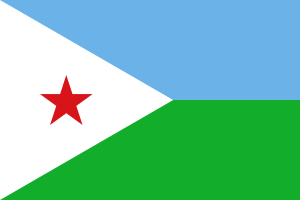
 Flag of Tunisia
Flag of Tunisia



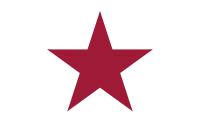 California Lone Star Flag - 1836.
California Lone Star Flag - 1836. Flag of Washington, D.C..
Flag of Washington, D.C.. Flag of Acre State, Brazil.
Flag of Acre State, Brazil. Flag of Pashtunistan.
Flag of Pashtunistan. Flag of Nagasaki city.
Flag of Nagasaki city. Flag of Turkish Northern Cyprus.
Flag of Turkish Northern Cyprus. Flag of Birmingham, Alabama.
Flag of Birmingham, Alabama. Arms of Għargħur, Malta.
Arms of Għargħur, Malta. Moríñigo coat of arms.
Moríñigo coat of arms. Valais coat of arms
Valais coat of arms Crain, Yonne coat of arms.
Crain, Yonne coat of arms..svg.png) Chauriat coat of arms.
Chauriat coat of arms.
Symbol of animal relief
The red star was adopted as the symbol of the International Red Star Alliance, a Geneva international treaty signed in 1914 with the purpose of bringing about international cooperation on behalf of sick and wounded war animals, while securing the neutral status of the personnel engaged in such work. Besides the International Alliance, national Red Star societies were also established. Regarding animal relief, the International Red Star Alliance had an analogous role of that of the International Red Cross and Red Crescent Movement. To identify their neutral status, white brassards with red stars were worn by military veterinary personnel in World War I in a similar way medical personal worn brassards with red crosses.[9]
Following the War, the American Red Star turned to focus on domestic issues, including care for animals during disasters. The organization waxed and waned over the decades, and as of 2016 exists as the American Humane Association's Red Star Animal Emergency Services.[10]
Red stars in labels and logos
 Logo of Martinazzi
Logo of Martinazzi A San Pellegrino bottle
A San Pellegrino bottle- Label of a Heineken bottle
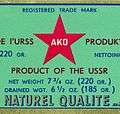 Logo of AKO, product of the Soviet Union
Logo of AKO, product of the Soviet Union Logo of Macy's department stores
Logo of Macy's department stores Texaco logo, circa 1913
Texaco logo, circa 1913 Caltex logo, circa 1936
Caltex logo, circa 1936 Sports club « Stella Rossa », Austria
Sports club « Stella Rossa », Austria
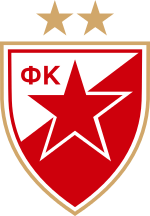


 Logo of the Benevolent and Protective Order of Elks
Logo of the Benevolent and Protective Order of Elks

The American soccer clubs Sacramento Republic FC and D.C. United also use red stars in their logos, referencing the flags of California and the District of Columbia, respectively.
The red star was used by the Texaco oil company in various forms from 1909-1981.[11] Its overseas division Caltex also used the red star until 1996. The Red Star is currently a registered trademark of Red*Star Auto Works Inc. (pic).
Holiday usage
_12.jpg)
The red star was commonly placed atop New Year trees in the Soviet Union, a tradition that continues to this day in Russia.
Legal status
The red star and the hammer and sickle are regarded as occupation symbols as well as symbols of totalitarianism and state terror by several countries formerly either members of or occupied by the Soviet Union. Accordingly, Latvia,[12] Lithuania,[13] Hungary[14] and Ukraine[15][16][17] have banned the symbol amongst other things deemed to be symbols of fascism, socialism, communism and the Soviet Union and its republics. In Poland, the Parliament passed in 2009 a ban that referred generally to "fascist, communist or other totalitarian symbols", while not specifying any of them.[18] Following a constitutional complaint, it has been abolished by the Constitutional Tribunal as contrary to the art. 42(1) (construed here as requiring adequate precision of a law that imposes penal liability) in connection with art. 54(1) (the freedom of speech) and art. 2 of the Polish Constitution (effective from 03.08.2011). A similar law was considered in Estonia, but eventually failed in a parliamentary committee as too onerous for constitutionally guaranteed freedoms, most importantly, freedom of speech. Georgia is planning to introduce measures banning communist symbols, including statues of Joseph Stalin.[19]
The European Court of Human Rights has ruled, in a similar manner, against the laws that ban political symbols, which were deemed to be in clear opposition with basic human rights, such as freedom of speech,[20][21] confirmed again in 2011 in case Fratanolo v. Hungary.[22] The decision has been compared[23] to the legislation concerning the symbols of Nazism, which continue to be banned in several European Union member states, including Germany and France.
There have been calls for an EU-wide ban on both Soviet and Nazi symbols, notably by politicians from Lithuania, Estonia, the Czech Republic, Hungary and Slovakia. The European Commissioner for Justice, Franco Frattini, felt it "might not be appropriate" to include communist symbols in the context of discussions on xenophobia and anti-Semitism.[24]
In 2003, Hungarian politician Attila Vajnai was arrested, handcuffed and fined for wearing a red star on his lapel during a demonstration. He appealed his sentence to the European Court of Human Rights, which decided that the ban was a violation of the freedom of expression, calling the Hungarian ban "indiscriminate" and "too broad".[25]
In Slovenia, the red star is respected as a symbol of resistance against fascism and Nazism. On March 21, 2011, Slovenia issued a two-euro commemorative coin to mark the 100th anniversary of the birth of Franc Rozman, a partizan commander, featuring a large star that represented a red star.
Non five-pointed red stars
Emblems and flags where the red stars displayed are not five-pointed are much rarer. Among these the following deserve mention.
 Three-pointed red star in the flag of the International Brigades.
Three-pointed red star in the flag of the International Brigades. Four-pointed red star in the flag of Aruba.
Four-pointed red star in the flag of Aruba.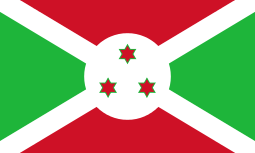 Six-pointed red stars outlined in green in the flag of Burundi.
Six-pointed red stars outlined in green in the flag of Burundi.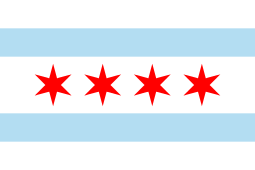 Six-pointed red stars in the flag of Chicago.
Six-pointed red stars in the flag of Chicago. The Chicago Red Stars soccer club uses a six-pointed red star derived from the Chicago flag.
The Chicago Red Stars soccer club uses a six-pointed red star derived from the Chicago flag. Seven-pointed red star in the flag of the Arakan Army (Kachin State)
Seven-pointed red star in the flag of the Arakan Army (Kachin State) Eight-pointed red star in the Naval Ensign of Singapore.
Eight-pointed red star in the Naval Ensign of Singapore.
See also
- Five-pointed star
- Red flag (⚑)
- Hammer and sickle (☭)
- Communist symbolism
- Star and crescent
- Star of Bethlehem
- Hollywood Walk of Fame
- FC Red Star Belgrade
- FC Red Star Saint-Ouen
- FK Velež Mostar
- Waasland-Beveren
- Pancho Villa Expedition, when American military aircraft used a red star insignia (1916–17)
External links
| Wikimedia Commons has media related to Red stars. |
- Flags with stars – Wikimedia Commons
- Blog: Heart in a Hearless World - on the origin of the red star
References
- ↑ Khvostov, Mikhail (1996), The Russian Civil War (1) The Red Army. Published by Men-At-Arms. ISBN 1-85532-608-6.
- ↑ Pri La Stelo: Militista simbolo
- ↑ Speech At the Parade on Red Square, 1 May 1923
- ↑ The Russian Civil War (1): The Red Army By Mikhail Khvostov, Andrei Karachtchouk, page 37 (there are several mentions of the use of the red star from 1918)
- ↑ "Historic Wings - Flight Stories - Chasing Pancho Villa". fly.historicwings.com. HW. March 15, 2013. Retrieved February 21, 2016.
Just one day after arriving, on March 16, 1916, the first reconnaissance flight was flown by Capt. Dodd with Capt. Foulois (as an observer) on the Curtiss JN-3 S.C. No. 43. As with all of the Army’s aircraft in that era, the plane carried simple markings — a red star on the tail and the large number 43 painted on the sides of the fuselage.
- ↑ https://heartinaheartlessworld.blog/author/heartinaheartlessworld/
- ↑ http://www.redstar.ru/
- ↑ Военно-воздушные силы отказались от трехцветных звезд Армия, Известия Russian: {{{1}}}
- ↑ Celebrating 125 years, American Humane Association
- ↑ http://www.americanhumane.org/assets/pdfs/animals/aes-redstar-1pager-41511.pdf
- ↑ "History of Texaco". Texaco.com. Retrieved 25 May 2016.
- ↑ "BC, Riga, 16.05.2013". The Baltic course. Retrieved 3 August 2014.
- ↑ "Lithuanian ban on Soviet symbols". BBC News. 17 June 2008. Retrieved 22 May 2010.
- ↑ "Act C of 2012 on the Criminal Code, Section 335: Use of Symbols of Totalitarianism" (PDF). Ministry of Interior of Hungary. p. 97. Retrieved 21 February 2017.
Any person who: a) distributes, b) uses before the public at large, or c) publicly exhibits, the swastika, the insignia of the SS, the arrow cross, the sickle and hammer, the five-pointed red star or any symbol depicting the above so as to breach public peace – specifically in a way to offend the dignity of victims of totalitarian regimes and their right to sanctity – is guilty of a misdemeanor punishable by custodial arrest, insofar as the did not result in a more serious criminal offense.
- ↑ Ukraine Bans Soviet-Era Symbols
- ↑ LAW OF UKRAINE. On the condemnation of the communist and national socialist (Nazi) regimes, and prohibition of propaganda of their symbols
- ↑ http://zakon4.rada.gov.ua/laws/show/317-viii
- ↑ "Poland Imposes Strict Ban on Communist Symbols". Fox News. 27 November 2009.
- ↑ Communist symbols to be banned in Georgia, BBC News, 4 May 2014, retrieved 13 May 2014
- ↑ ECHR judgment in case Vajnai v. Hungary
- ↑ Wearing a red star in Hungary 'is a basic human right' : Europe World
- ↑ Press release 222(2011). Registrar of ECtHR 03.11.2011.
- ↑ European Court considers Labour Party's red star – in Hungarian
- ↑ "EU ban urged on communist symbols". BBC News. 3 February 2005. Retrieved 22 May 2010.
- ↑ Curry, Andrew (2009-11-24). "Vestiges of 'Genocidal System': Poland to Ban Communist Symbols". Spiegel. Retrieved 2013-09-14.



.svg.png)

